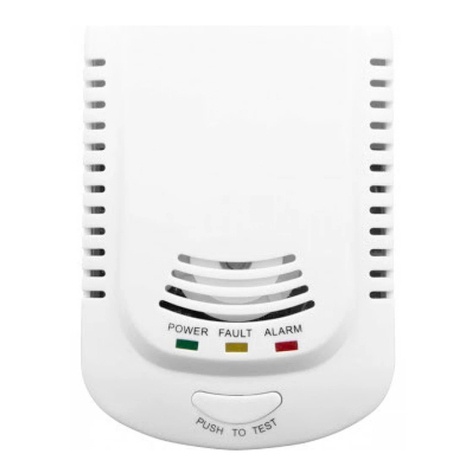
User manual for SR-1007
Your purchase and use of SR-1007 gas alarm is much appreciated. Please read these
instrucons BEFORE using the device, and make sure to keep this manual aer carefully
reading it, for the future reference.
1. Summary
The household gas alarm has been developed by adopng advanced electronic and gas
detecng techniques. It is highly sensive and is applicable to detect the leakage of
household gasses, liquid gasses and natural gas. The sensor reacts with the diffused
gases in the air directly and generates a linear voltage signal. When the detected gas
density reaches a specific value, the alarm emits an acousto-opc alarm signal to remind
its users to take appropriate measures in me. SR-1007 gas alarm has a modern, smart
design, and is convenient to use.
2. Technical Parameter
• Rated voltage: AC230 V / 50~60 HZ
• Power dissipaon: <2,5 W
• Operang temperature: 0°C ~ + 50°C
• Operang humidity: 10%~95% RH
• Alarming level of gas density: 2500 PPM (+/- 1500 PPM)
• Alarm loudness / effecve range: ≥85 dB @ 1 m
• Dimensions: 105 * 72 * 28 mm
3. Operaon
A) Plug in the gas alarm to mains, so that it can preheat (for about 2 minutes), with red
indicator light being turned on. During this me, the gas alarm does not detect gas.
Aer the device finishes preheang, the red indicator light will turn off. That is a sign
that shows the detector is in a tesng mode. (it may emit alarms when being plugged
into mains, and will switch to normal operang mode aer preheang, a few minutes
later.)
B) Tesng mode: Press the test buon for a few seconds, the red indicator light will
start to flash, and the gas alarm will emit sounds. That means the detector is working
well. Install the gas alarm in the desired place (aer tesng it) and plug it into the
power supply accordingly.
C) In case of events, the alarm has tested the corresponding density of the gas, the
red indicator light will flash and emit sound alarms. That reminds the users to take
appropriate measures in me.
D) Press the test buon with regular intervals, to make sure the alarm is in normal
operang mode and make sure to keep the surrounding area clean.
WARNING: If the yellow LED on the device is connuously lit, it means that the
detector's sensor has been damaged, and it no longer performs its funcons - THE
SENSOR'S LIFECYCLE LASTS ABOUT 5 YEARS.
4. Installaon
A) If this parcular device is used to detect natural gas, please install the alarm in place
at least 50 cenmeters away from the ceiling, as well as, within 1,5m distance from the
natural gas source. The main component of natural gas is methane, which is lighter than
air. Therefore, the gas alarm should be mounted on the walls should not be placed
below the top frame of doors or windows.
B) If this parcular device is used to detect compressed petroleum gasses or city coal
gasses, their main components are propane or butane, which are heavier than air.
Therefore, the alarm should be mounted in lower places, generally installed at a distance
of less than 30 cm from the ground and within a distance of 1.5m away from the LPG
source. On top of that, there should be no doors or windows located, between the
alarm and LPG source. That prevents the leakage of the gas, from reaching the detector
for the first me.
Gas alarm CANNOT be installed in the following places:
A) Do NOT install the alarm at the top of the cooker (similar kitchen appliances), as
smoke, fat and /or dirt may negavely affect alarm’s funconality.
B) Do NOT install the alarm above the sinks (or any water containers), as water splashes
(humidity) and /or dust may negavely affect alarm’s funconality.
C) Do NOT install the alarm in places, where there are air / vent holes, fans or any other
venlated places nearby. This may prevent the leakage of gas from reaching the alarm
for first me.
D) Do NOT install the alarm in ghtly-covered concealed places. This may delay the
proper detecon of gas leakage.
E) Do NOT install the alarm outdoors or in places with humidity being lower than 10%
or higher than 95%.
5. Warning
A) Do use special fings for any possible repairs, to avoid damaging the product.
B) Do not repair the gas alarm by yourself. Let the professionals handle the
maintenance.
C) Make sure to keep the household gas alarm and its packaging materials, out of reach
of the children.
D) The product warranty does not cover any improper use or human-made damage.
6. Warranty
The product is covered by 24-month warranty.
EN PLPL
The WEEE symbol (the crossed-out wheeled bin) usage indicates that this product is
not a household waste. Appropriate waste management aids in avoiding consequences,
which are harmful for people and environment and result from dangerous materials
used in the device, as well as, improper storage and processing of such equipment.
Segregated household waste collecon allows recycling of materials and components of
which the device was made of. In order to get detailed informaon about recycling of
this parcular product, please contact your retailer or a local authority.
Użycie symbolu WEEE (przekreślony kosz) oznacza, że niniejszy produkt nie może być
traktowany jako odpad domowy. Prawidłowa utylizacja zużytego sprzętu pozwala
uniknąć zagrożeń dla zdrowia ludzi i środowiska naturalnego, wynikających z możliwej
obecności w sprzęcie niebezpiecznych substancji, mieszanin oraz części składowych,
a także niewłaściwego składowania i przetwarzania takiego sprzętu. Zbiórka selektywna
pozwala także na odzyskiwanie materiałów i komponentów, z których wyprodukowane
było urządzenie. W celu uzyskania szczegółowych informacji dotyczących recyklingu
niniejszego produktu należy skontaktować się z punktem sprzedaży detalicznej,
w którym dokonano zakupu, lub organem władzy lokalnej.
























